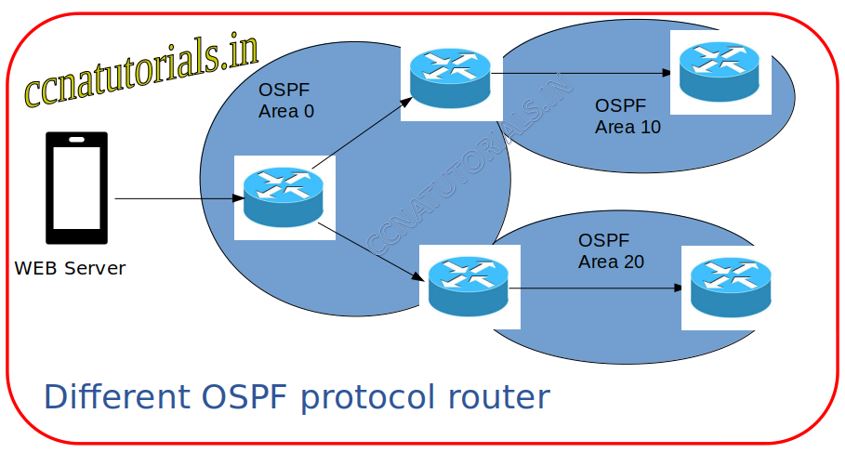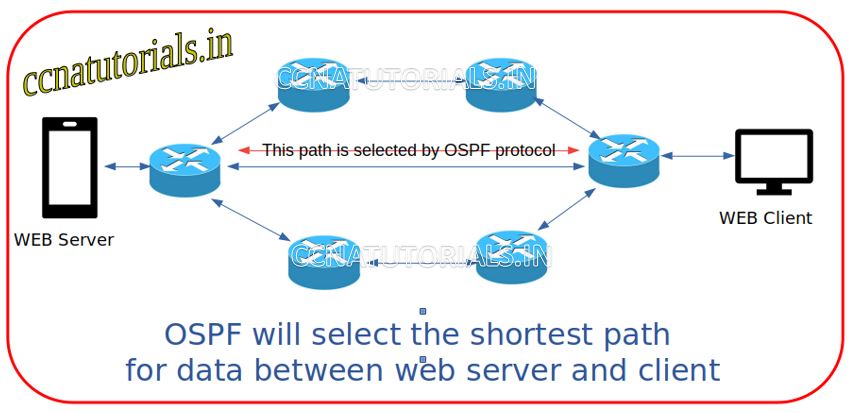In this article I describe the OSPF Open Shortest Path First in computer network for CCNA exam. OSPF Open Shortest Path First is related to Link layer of TCP/IP Suite model. OSPF Open Shortest Path First is a router protocol which provide the path to the data packets in the network or internet. The OSPF Open Shortest Path First provide the delivery of data packets in a large network which can not handle by other routing protocols like RIP and RIPv2. OSPF Open Shortest Path First works very fast, it updates the routing table on any change in the network.
The OSPF Open Shortest Path First broadcast only the changes in the network like if there is any router goes out of order or any new router added in the network. The convergence time of OSPF is very less than other routing protocols. OSPF supports both version of IPv4 and IPv6 address system in any network. OSPF version 2 defined as RFC 2328 and OSPF version 3 defined as RFC 5340. OSPFv2 related to a IPv4 address system and OSPFv3 related to IPv6 address type in any network.
Before going to learn about OSPF Open Shortest Path First in detail, it became helpful to remember the OSI suite and TCP/IP suite model. There are many manufacturer of computer machine in the market. Initially when computers became single user public computer. The computers communicate with only same brand machines. It happens because there was no any fix standard for data transfer between different devices. It is very difficult to make communication with each other when the hardware are of different brands or company. In this article I describe the some basic part of OSI reference layer and TCP/IP Suite model basic concepts in networking with the OSPF Open Shortest Path First.
OSI reference model basic concepts
OSI reference model in computer network followed by various vendors to overcome the compatibility problem. After implementation of OSI reference model in computer network, equality maintains by all manufacturer. In 1970 the Open Systems Interconnection (OSI) reference model was created by the International Organization for Standardization (ISO). The OSI model was meant to create inter-operable network with different manufactured devices. In this article I describe some layered approach of TCP/IP Suite model basic concepts in computer network. Before understanding the TCP/IP Suite model basic concepts it is necessary to know about the 7 layers of OSI reference model because the basic work of each layer is described in the OSI reference model. You can read the full article related to OSI reference model in computer networking here.
Importance of OSI reference model for OSPF Open Shortest Path First
Before going to know about the OSPF Open Shortest Path Firstat link layer. It is necessary to know the function of layers in OSI model and TCP/IP model. Initially not only hardware but software also not supported for work the different computer brand. It became very difficult for all computer users to working without implementation of OSI reference model in computer network. It is necessary then to make some common protocols for all vendors of computer. Before implementation of OSI reference model in computer network, all vendors implements their own protocols on computer hardware and software.
In networking OSI reference model became helpful. OSI reference model describes the flow of data between nodes in any network. Data from one computer application to another computer application transfer by following some common protocols. The OSI reference layer also become beneficial for troubleshooting the network problems. TCP/IP and Cisco three layered hierarchical model of Cisco became more helpful alongside the OSI reference model.
The Layered Approach in computer network
The Layered approach was the best way to make equality for all computer devices. Layers are not physical but following some protocols. Protocols are for connectivity, connections, data transfer and more. All manufacturer begin to follow the layered approach for OSI reference model in computer network. The OSI reference model change in TCP/IP reference model and later on Cisco three layered hierarchical model. OSI layer architecture have 7 layers. TCP/IP reference model convert these 7 layers into only four layers. After that Cisco three layered hierarchical model converts these 7 layers into three layers. Some layers combined to work in a single layer.
OSI is acronym for open system interconnection. The OSI is a logical reference OSI reference model in computer network. OSI model helps for data flow between different devices and operating systems. All manufacturer used their own architecture before invention of OSI reference model. It was very difficult to establish data communication between different devices. To overcome this problem international organization for standardization (ISO) created the open systems interconnection (OSI) reference model. OSI reference model make data flow possible between different operating system, devices and hardware. Later the OSI model adopted by Cisco as Cisco three layered hierarchical model.
Structure of OSI reference model related to OSPF Open Shortest Path First
OSI reference model in computer network consist of 7 layers. These 7 layers further divided into two groups. First 3 layers works for application communication and remaining 4 layers works for data flow. Application, presentation and session layers define the application communication. Transport, network, data link and physical layers define the data flow. Networking protocols works only on last four layers.
TCP/IP Suite model basic concepts for OSPF Open Shortest Path First
TCP/IP is acronym for Transmission Control Protocol/Internet Protocol (TCP/IP suite model). In this section of the article I describe about TCP/IP suite model basic concepts in detail. TCP/IP suite model is a reference model like OSI layers. Instead of 7 layers of OSI reference model. TCP/IP suite model consist only four layer. All seven layers are merged into four layers only. TCP/IP suite model was designed and implemented by Department of Defence (DoD). TCP/IP developed to preserve data integrity. The main purpose to develop the TCP/IP is to provide security in the network. A lots of protocols works on each layer to provide a secure network.
It is necessary to understood the protocols used in TCP/IP Suite model basic concepts. IP addressing play an important role in TCP/IP Suite model basic concepts. By using the IP address and subnet masking broadcast domain breaks. It will improve the performance of the network. Breaking broadcast domain increase the data flow speed. Here IP stands for IPV4 only. We ignore the IPV6 for some time in this article. It will make it easy to understand the TCP/IP Suite model basic concepts.
A snap of TCP/IP Suite model basic concepts
In the decade of 1970’s TCP/IP suite model developed by DoD. In the initial stage TCP/IP suite model divided into two segments TCP and IP. Later its name registered with combined name of TCP and IP like TCP/IP model. ARPA, the Advanced Research Projects Agency of DoD officially authorised to use TCP/IP suite model. TCP/IP model was working well so it was adopted by many organisations. In today scenario it is mostly using reference model for networking. Internet is the best example of using TCP/IP.
Process or Application layer of DoD model in TCP/IP Suite model
This is the first layer of TCP/IP of DoD model. It is combination of top three layers of OSI reference model. The functions of Application layer, presentation layer and session layer in OSI model works in single layer process layer. This layer supports the point to point communication and controls the user interface. The data encryption and decryption also done at this layer. Example of some protocols functions at this layer are TLS Transport Layer Security, FTP, LPD, TFTP, SMTP.
Transport layer of DoD model in TCP/IP Suite model
Transport layer of TCP/IP is same as the Transport layer of OSI reference model. It supports the TCP and UDP protocol. This protocol converts the main data segment into packets and transport to the internet layer. The responsibility of Transport layer is to combine the segments and built the data. The data should be reconstruct in its real form. Transport layer is also responsible for creating end-to-end communication between sender and receiver. This layer ensure the delivery of segment in sequence at the receiving device. This property maintains the data integrity.
Internet layer of DoD model in TCP/IP Suite model
Internet layer of TCP/IP is similar to the network layer of OSI reference model. Routing protocols functions on Internet layer of TCP/IP model. Addressing and filtering of packets is main responsibility of Internet layer of TCP/IP model. This layer provides the transmission of packet in the whole network. Some example of protocols functions on internet layer are ICMP, ARP and IP.
Link layer of DoD model in TCP/IP Suite model
Link layer is the least layer of TCP/IP. Basically link layer is combination of data link and physical layer of OSI reference model. Link layer is also known as Network Access layer. It works on MAC address based data transmission. Link layer handles the frame and bits. It receive the bits and constructs frame from merging bits in a sequence. In case of any bit is missing this layer request to re transmit the bits. Ethernet, FDDI, WAP etc functions on this layer. There is no any preset specification for link layer. Link layer functions on any type of existing media.
OSPF Open Shortest Path First Explained in Brief
OSPF Open Shortest Path First is a link layer protocol in TCP/IP model. The OSPF Open Shortest Path First provide the best path to flow the data between routers. Selection of best path is based on distance and speed of the link. Routers are main networking device which connects different networks. This is known as inter-networking. Internet is an example of inter-networking. OSPF is a link state routing protocol. OSPF is fully classless protocol.

On internet data transfers between two devices via numbers of routers. Each router maintains a routing table. Routing table contains the link speed connected routers and distance. To transfer the packets from one device to another device path selection is necessary. OSPF Open Shortest Path First was invented for Selection of best path to deliver the data in less time and efficiently.
Function of OSPF Open Shortest Path First protocol
OSPF protocol is responsible for moving packets within a network of routers. Multiple routers connected with each other to provide connectivity on internet. When a user search for a web page in browser, a lots of protocol work for making connection between host and web server. There may be a lot of numbers router involved for transfer the data. If a router is using OSPF protocol, it will select the best path to make communicate the web host and web server.

OSPF works on protocol number 89 and AD value 110. Here AD is Administrative Distance. Later we brief the function of Administrative Distance. Another thing is cost metrics used for selection of best path. Cost metrics is a logical terms define in routers for link state. The higher speed link allotted higher cost metrics. For example Ethernet link have low cost metrics than fiber link. OSPF uses 224.0.0.5 and 224.0.0.6 IP address for multicasting. OSPF protocol advertise its routing table to nearest Router for updation of table.
Advertisement in OSPF protocol
The OSPF Open Shortest Path First replace the old techniques of routing. If there is any change in routing table in a router, the router broadcast the changes of the table to all nearby routers for updation. Old protocol broadcast the complete table which causes congestion in network. When a router goes defective, the neighbor routers immediately broadcast it so the data flow through it can be diverted.
To shake hand in OSPF Open Shortest Path First router should be configured same area. Subnet mask of the routers should be same. Stub flags should be match in both routers. Hello and dead timer should be same in both routers.
OSPF Open Shortest Path First related terms
OSPF Open Shortest Path First is a link-state routing protocol. The OSPF provides the best path for data packets between different routers in the internetwork. Following are some terms related to OSPF Open Shortest Path First protocol.
- Router ID- it is an IP address by which the router identified in a network. Router ID is generally the highest IP address of a network segment on an interface of router. Generally first loopback address is suppose to be the Router ID in the network.
- Designated Router- generally denoted by short term as DR in an OSPF enabled network. The router in the network which have DBD of all routers of the network, elected as DR. Here DBD denotes the DataBase Descriptor packet. We can say the DR keep the information of all router’s routing database.
- Backup Designated Router- Generally denoted by shord term as BDR in an OSPF enabled network. As name denotes the BDR is the backup router for the DR in the network. It means in case of failure of DR the BDR will automatically take over the charge of DR in the network.
- Router Priority- it is used to select the DR and BDR in a broadcast network. Router Priority is generally a 8 bit value allotted to a router. Here DR denotes the Designated Router and BDR denotes the Backup Designated Router.
OSPF Open Shortest Path First protocol states in networking
There are multiple OSPF Open Shortest Path First states used by router in a network. Some of these state are following.
- Down- Down state indicates that no any packet will be receive on the down interface. Down means the interface is not physically down. the state Down indicate that the interface will not take a partition in OSPF process in the network.
- INIT- INIT state allowed to receive the hello packets from other router in the OSPF enabled network.
- 2WAY – 2WAY state provide the indication of receiving hellow packets from other routers in the network. The election of DR and BDR done before the 2WAY state.
- Exchange – Exchange state allowed to exchange the DBD (DataBase Descripter).
- Exstart – Exstart state allowed the exchange of Null DBD between routers. The selection of master and slave router done in this state. The router which have higher Rotuer ID become master and the router of Router ID with lower IP address become slave in the network.
- Full – Full state indicates that the convergence of OSPF network is complete. We can say all OSPF data synchronized between all routers of OSPF enable network.
Messages used by OSPF Open Shortest Path First
OSPF protocol uses certain messages for the communication between the routers. Hello message, Dead message, Database Description, Link state request, Link state update and Link state ack. By the name of the message the meaning of message is under stood. OSPF supports both IPv4 and Ipv6 internet protocol suite.
In this article I describe the OSPF Open Shortest Path First in computer network for CCNA Exam. I hope you found this article helpful for any query or suggestions you may drop a comment below or contact us. Your suggestions are always welcome by us.






